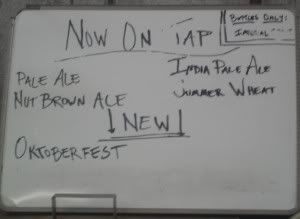 (This post is part of an assignment for the class I am taking, Writing for Digital Media at the School of Journalism and Mass Communication, University of North Carolina at Chapel Hill.This week, I am writing an article that includes excerpts from interviews I conducted. The audience of this article is intended to be my professor, classmates, and anyone with an interest in alternative fuels.)
(This post is part of an assignment for the class I am taking, Writing for Digital Media at the School of Journalism and Mass Communication, University of North Carolina at Chapel Hill.This week, I am writing an article that includes excerpts from interviews I conducted. The audience of this article is intended to be my professor, classmates, and anyone with an interest in alternative fuels.)By Marcie Barnes
Many of you may have heard of biodiesel, which is gaining popularity across the country as an alternative to regular "virgin" diesel. Biodiesel is made (or converted) from vegetable (or animal) oil and typically can be used (usually blended with regular diesel) in any engine that uses diesel fuel without modification, as well as in oil furnaces. Therefore, people with diesel engines or oil furnaces already have the "technology" in place to begin using biodiesel.
Lyle Estill, "V.P. of Stuff" (deleted: "of") for Piedmont Biofuels, said (deleted "told me") in an interview that he began making biodiesel for personal use (moved) in his backyard in 2002, at the rate of about 55 gallons per month. Now, he is producing approximately one hundred thousand gallons of the "stuff" each month from his Pittsboro, N.C. operation, and selling it to private citizens as well as other businesses.
He also told me that his customers are not just using it to power their cars. "Some make bug spray,” he said. “Some make asphalt cleaners, some make furniture polish. Some use it for boiler fuel. Some use for home heating." (rearranged)
Interesting stuff. (deleted: "I couldn't really find any") Information on (deleted: "the") biodiesel bug spray or furniture polish was not found (deleted "anywhere"). But (deleted: "I do think it's helpful for") information for people, typically in colder climates who have oil furnaces, (deleted: "to realize that") abounds. A biodiesel blend is a perfectly acceptable alternative fuel for them. In western North Carolina, blueridgebiofuels.com is a good place to start to find suppliers in your area. There's also a good explanation of how it works on practicalenvironmentalist.com.
The NC Solar Center at NC State University, (deleted: "which") "serves as a clearinghouse for solar and other renewable energy programs, information, research, technical assistance, and training for the citizens of North Carolina and beyond," according to (deleted: "their") its web site. It launched a campaign last year specifically designed to increase awareness about heating your home with biofuels, called "Bioheat® is Better."
Anne Tazewell, the Center's transportation program manager, supplied (deleted: "me with") an overview of the project which told of its success: "Overall the project raised awareness about this product to heating oil distributors and customers resulting in more use of biodiesel and an expanded market for soybeans," it said.
A Biodiesel Bus Wrap project slated for this year (deleted:",") unfortunately did not receive funding, she (deleted: "told me") said in an interview. Most of the funding comes from outside sources – "mainly state grants, but sometimes federal grants" - according to another Center employee.
I also spoke to a regular consumer of biodiesel, Tim Morton, who is a Landscaping Manager at SAS* in Cary, NC. SAS is a software company that, in addition to developing software to help other companies achieve sustainability, also is a steward for being a responsible, green company.
Tim (deleted: "tells me") said he is paying about $4.50 per gallon for the biodiesel he is getting from a local supplier. "We have just started using some small amounts of biodiesel in some of our SAS Landscaping equipment. We are mixing in 5-10% biodiesel with regular diesel fuel," he said. Reducing usage of virgin diesel fuel and recycling used waste cooking oil products are the benefits he reports.
Overall, the future looks bright for biofuels as more and more consumers look for alternatives to foreign oil, especially in vehicles. One readily available vehicle worthy of note is the Jetta TDI Clean Diesel. What is clean diesel, you ask? Check it out. These vehicles are getting excellent gas mileage (better than hybrids, and they are better than hybrid for other reasons, according to this popularmechanics.com article) and produce radically cleaner emissions at the same time, unlike your father's diesel engine that spewed dirtiness on the car and into the air.
Time to start putting our minds and dollars towards these local, environmentally-friendly fuels and buying into technology that supports them. Once again, if you have a diesel engine or oil furnace, you already have the technology.
More assignment stuff:
Questions posed to: Anne Tazewell, Transportation Program Manager, NC Solar Center/NC State University:
1. I see that last year you had a campaign called “Bioheat® is Better” and that you planned to follow that up by measuring the effectiveness of the campaign – are those results available somewhere or can you share them with me?
2. Are there any new projects to promote biodiesel in the future lined up?
3. How is this year’s program, Biodiesel Bus Wrap, going?
4. Anything else you can add about these awareness programs and the public’s response to biodiesels is much appreciated.
Question posed to: Chelsea Conover, NC Solar Center/NC State University:
Does your funding come solely from the University, or are there other sources from which you seek funding?
Questions posed to: Lyle Estill, "V.P. of Stuff" of Piedmont Biofuels:
1. Can you tell me how long you have been in the biofuels business and what kind of growth you have seen over time?
2. Do any of your customers (that you know of) use biodiesel for applications other than fueling vehicles (bioheat)?
3. Where do you see the future of biodiesel going, esp. in light of other renewable energy sources such as ethanol, solar, etc.?
Questions posed to Tim Morton, biofuel consumer at SAS in Cary, NC:
1. How much are you paying for biodiesel?
2. Where you are getting it from?
3. Aside from the obvious “going green” –are there other advantages to using it?
How I would further webbify the article:
1. Add a YouTube video on how to make biodiesel.
2. Go on a tour of the facility in Pittsboro and expand with a photo album with captions about what they do there.
3. Include a Google map of gas stations that sell biodiesel.
How I fact-checked:
Most of this is evident in the hyperlinks I added. There is a ton of information out there about this subject matter, so I tried to read three or four sites to get a perspective and linked to one that I thought was most useful. Another example is where I linked to the press release from the NC State Fair about cooking oil. I also linked to the Bioheat® is Better because it was a little confusing to me why the term was registered. Turns out the National Biodiesel Board (NBB) and National Oilheat Research Alliance (NORA) have recently trademarked the term, and launched the official logo for this product. Didn't feel a need to talk about it in the article, but dig a little deeper to find out about it.
-------------------------------
* Marcie is an employee of SAS.
Photo courtesy of robseattle on flickr.












